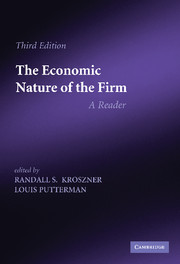Book contents
- Frontmatter
- Contents
- Editors' preface
- Reintroducing The Economic Nature of the Firm
- Part I Within and among firms: the division of labor
- Part II The scope of the firm
- 7 The nature of the firm
- 8 Vertical integration, appropriable rents, and the competitive contracting process
- 9 The governance of contractual relations
- 10 The limits of firms: incentive and bureaucratic features
- 11 Bargaining costs, influence costs, and the organization of economic activity
- 12 The boundaries of the firm revisited
- Part III The employment relation, the human factor, and internal organization
- Part IV Finance and the control of the firm
- References
9 - The governance of contractual relations
Published online by Cambridge University Press: 05 June 2014
- Frontmatter
- Contents
- Editors' preface
- Reintroducing The Economic Nature of the Firm
- Part I Within and among firms: the division of labor
- Part II The scope of the firm
- 7 The nature of the firm
- 8 Vertical integration, appropriable rents, and the competitive contracting process
- 9 The governance of contractual relations
- 10 The limits of firms: incentive and bureaucratic features
- 11 Bargaining costs, influence costs, and the organization of economic activity
- 12 The boundaries of the firm revisited
- Part III The employment relation, the human factor, and internal organization
- Part IV Finance and the control of the firm
- References
Summary
Contractual variety is the source of numerous puzzles with which the study of the economic institutions of capitalism is appropriately concerned. Transaction cost economics maintains that such variety is mainly explained by underlying differences in the attributes of transactions. Efficiency purposes are served by matching governance structures to the attributes of transactions in a discriminating way.
Contracting traditions
There is widespread agreement that the discrete transaction paradigm – “sharp in by clear agreement; sharp out by clear performance” (Macneil, 1974, p. 738) – has served both law and economics well. But there is also increasing awareness that many contractual relations are not of this well-defined kind. A deeper understanding of the nature of contract has emerged as the legal-rule emphasis associated with the study of discrete contracting has given way to a more general concern with the contractual purposes to be served. Macneil's distinctions among classical, neoclassical, and relational law are instructive.
Classical contract law
As Macneil observes, any system of contract law has the purpose of facilitating exchange. What is distinctive about classical contract law is that it attempts to do so by enhancing discreteness and intensifying “presentiation” (1978, p. 862), where presentiation has reference to efforts to “make or render present in place or time; to cause to be perceived or realized at present” (1978, p. 863, n. 25).
- Type
- Chapter
- Information
- The Economic Nature of the FirmA Reader, pp. 116 - 126Publisher: Cambridge University PressPrint publication year: 2009



